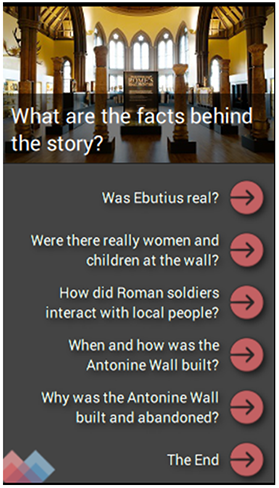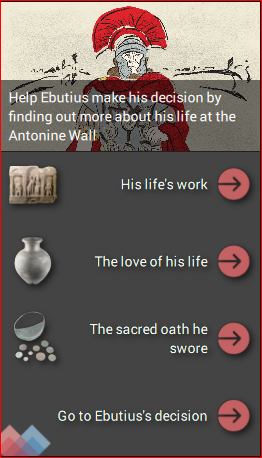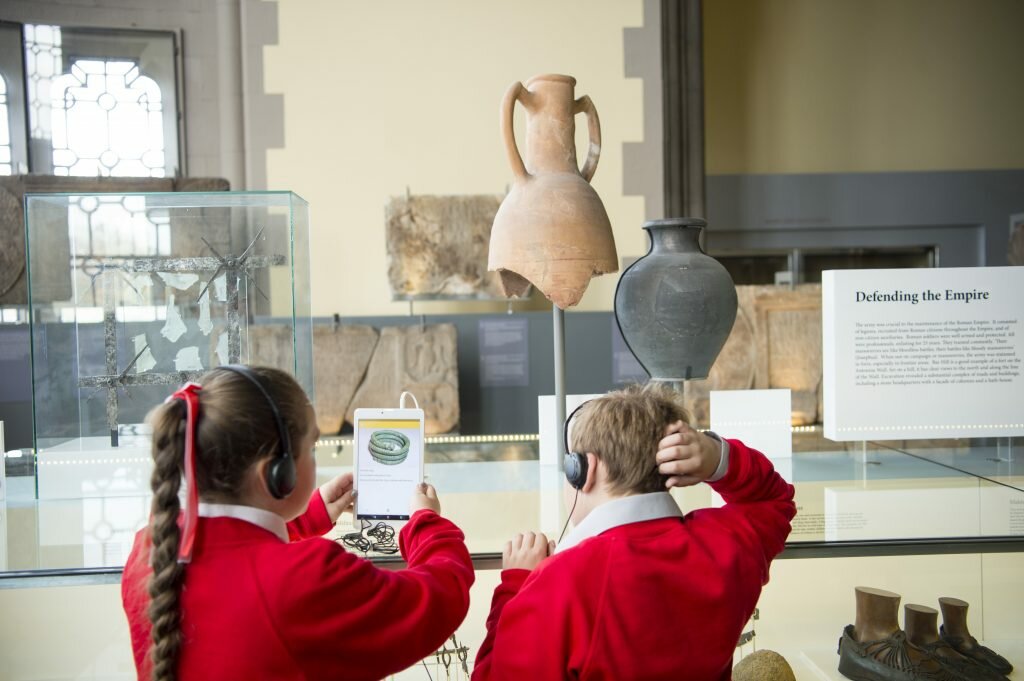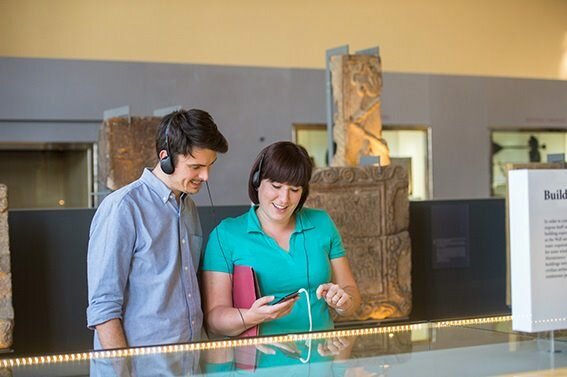‘Ebutius’s Dilemma’, Hunterian Museum Onsite Experience - Context
The Antonine Wall Site
Built around AD142 in the reign of the Roman emperor Antoninus Pius, the Antonine Wall ran coast-to-coast across Scotland from the Clyde to the Firth of Forth and was the most northerly frontier of the Roman Empire. It was abandoned by the Romans who retreated further south, from the late AD150s onwards.
The Hunterian Museum and its Antonine Wall Display
The Hunterian at the University of Glasgow was founded in 1807. It is Scotland’s oldest public museum and home to one of the largest collections in Scotland with over 1.5 million items. ‘The Antonine Wall: Rome’s Final Frontier’ is the Hunterian’s permanent display of the largest collection of artefacts discovered along the Wall.
THE EBUTIUS’S DILEMMA HUNTERIAN EMOTIVE EXPERIENCE
The Ebutius Hunterian EMOTIVE
The first experience features the character of Ebutius, a centurion, named after the name found scratched on one of the hammerheads found on the Wall currently on display at The Hunterian. The scenario covers the abandonment of the Antonine Wall by the Romans, and started with the conceptual idea of ‘The Things We Leave Behind’ from which derived the experience finalised later as ‘Ebutius’s Dilemma’. ‘The Things We Leave Behind’ helped explain how the objects currently on display in the Hunterian Museum used to belong or be used by people who lived and worked on the Antonine Wall but were left behind when the Wall was abandoned. This also encouraged visitors to reflect on parallels with their life today and the conditions that might make them leave material evidence behind and what this can reveal about our society, values, and way of living.

The aims of the ‘Ebutius’s Dilemma’ experience were:
· To connect with the Antonine Wall through the story of the character of a Roman centurion
· Address universal themes (e.g. family, work, love, loss)
· Encourage empathy and emotional engagement
· Engage with objects in the gallery
· Challenge stereotypes (e.g. about military life, the relationship of Romans with locals)
Outline of narrative and experience structure of ‘Ebutius’s Dilemma’
In order to experience ‘Ebutius’s Dilemma’, visitors in the Antonine Wall gallery are given a smartphone with a set of headphones and assisted to launch it using an app. The experience starts with Ebutius introducing himself. His speech is displayed on screen as text together with the graphic of a centurion, as well as a voice-over. On the following screen Ebutius then explains the dilemma he faces: He must decide before sunrise whether to leave his home – the Roman fort at the site of Bar Hill - with the rest of the army, or stay behind with his partner, a local woman named Calle and their son Callum. He then asks the user to help him make this life-changing decision and in order for visitors to be able to do that, they are invited to first learn more about Ebutius and his life.

The experience has three main strands: one relates to Ebutius’s working life, another to his personal life and a third to his sense of honour and duty. These strands, and the museum objects that are cited within them, are all labelled according to the emotional relevance or significance they hold for Ebutius. So, for example, a Roman distance slab is linked with ‘His life’s work’ or a pair of children’s shoes with ‘My dear sweet child’. By using emotive language and labels in this way, the experience encourages visitors from the beginning to foster a connection and empathy with the characters and the story.
The different experience strands weave in the objects on display, directing the users to find the related artefacts and encouraging them to engage with them in new ways, beyond seeing them only as museum objects, and referring to underlying universal themes such as work, love, and family and linking them with Ebutius’s personal story.
At various points in each experience strand visitors are given choices, either to hear other segments related to Ebutius’s life, such as his career as a builder or to discover some general information about the object itself. If they choose the object they see an image of it on screen, with touchable hotspot areas which offer further information, usually archaeological facts, relating to the specific object and similar to the text in the museum label.
Visitors can continue to explore Ebutius’s life story by going another level into this narrative or they can return to the main menu and explore the other strands, The love of his life or The sacred oath he swore, with similar structure and mechanics. At any point within the experience the user is able to choose to make the decision for Ebutius based on what they have found out about him from the experience.
THE EBUTIUS’S DILEMMA HUNTERIAN EMOTIVE VIRTUAL EXPERIENCE
In order to position the offsite virtual experience and the story of ‘Ebutius’s Dilemma’ within the Antonine Wall display, a photo-realistic representation of the gallery was required with objects located within this representation and identifiable to the user. The virtual walkthrough of the Antonine Wall gallery is based on 12 360° images of the gallery, as well as images of the display cases and objects taken on-site by the University of Glasgow team at the Hunterian Museum using a 360° camera. These images were manually fed into to the Floor Plan Editor tool to create a 360° panoramic view of the physical space. This virtual walkthrough serves as the foundation within which to embed the story, in this case, ‘Ebutius’s Dilemma’. Two EMOTIVE authoring tools were used to create the offsite virtual version of ‘Ebutius’s Dilemma’, the Storyboard Editor and the Floor Plan Editor. The existing assets related to the latest version of the ‘Ebutius’s Dilemma’ onsite experience were extracted from the Storyboard Editor and fed into the Floor Plan Editor by the ATHENA and University of Glasgow teams. Users access the offsite virtual experience of ‘Ebutius’s Dilemma’ via a link on the web using their own online connection and device.
Both the onsite and the online version of the Ebutius’s dilemma app have been extensively evaluated with a range of physical and virtual visitors. The results of our evaluations showed that the app and the whole EMOTIVE approach are making a major contribution to the state of the art of digital heritage practice, due to their capacity to engender visitor engagement with museum displays and cultural heritage sites, and – most importantly – their potential for emotionally connecting visiting audiences with the distant human past.

